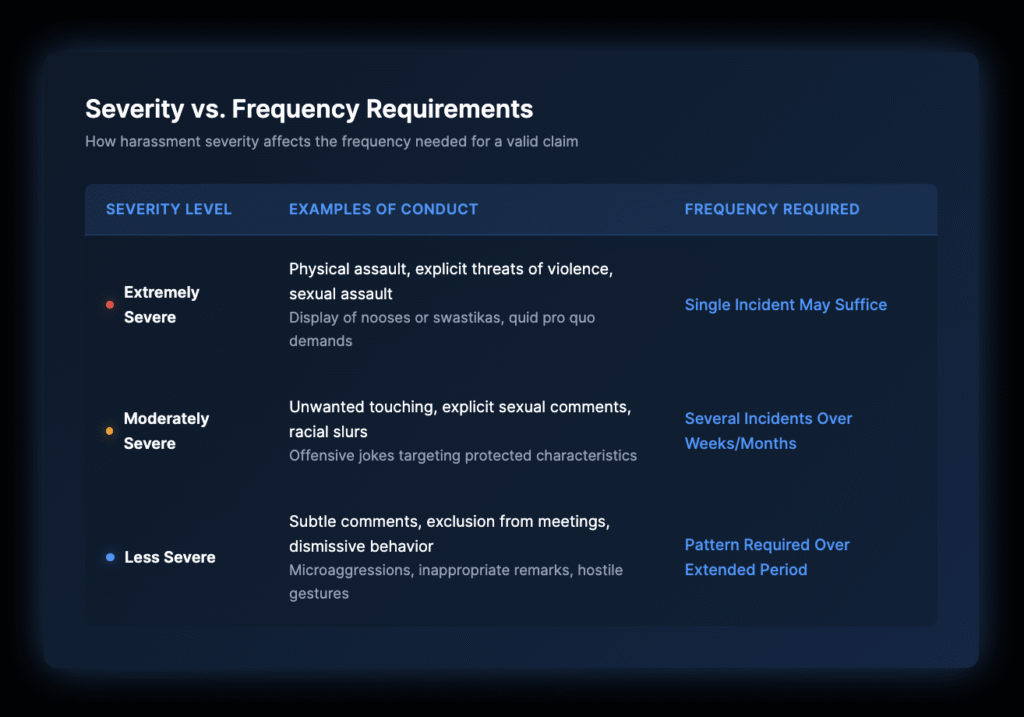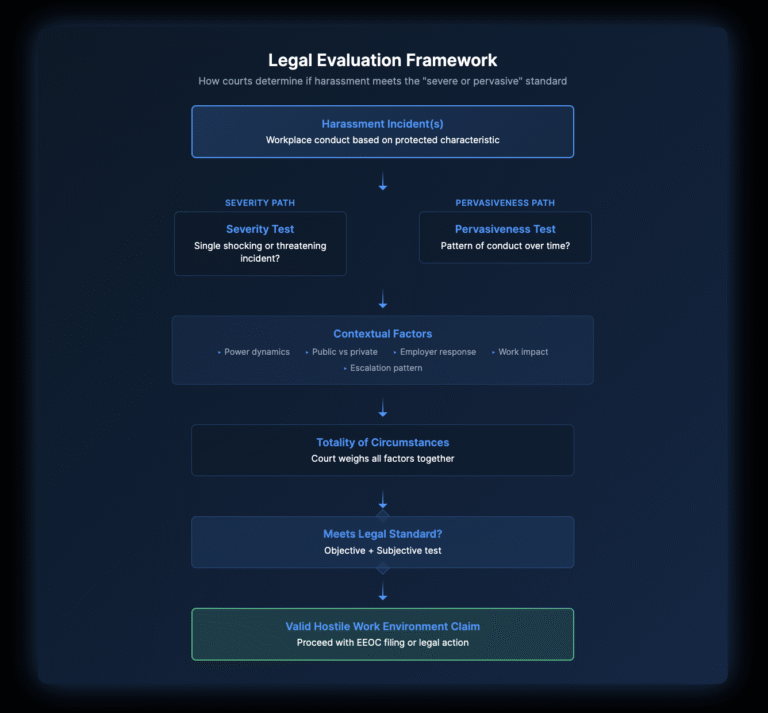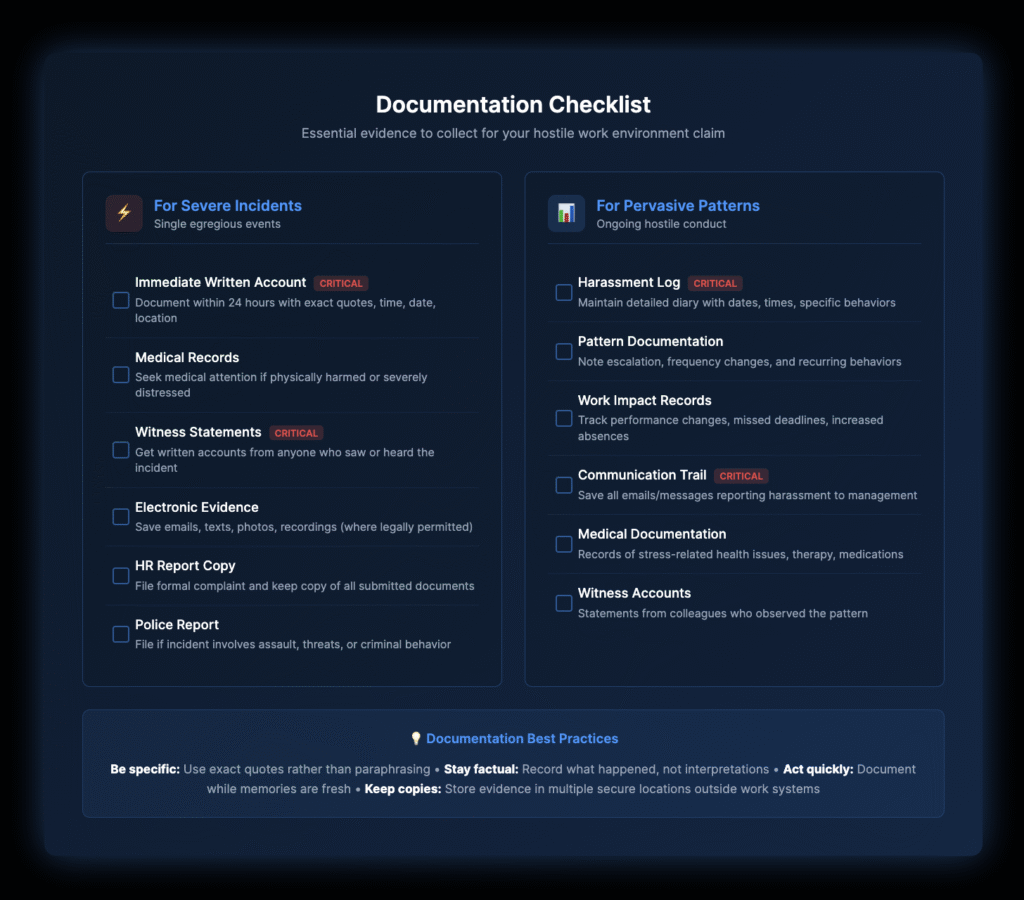The “severe or pervasive” standard determines whether workplace harassment violates federal anti-discrimination laws. You don’t need both—harassment must be either severe enough that a single incident creates an abusive environment, OR pervasive enough that repeated conduct fundamentally changes your working conditions. Courts evaluate severity by asking if a reasonable person would find the conduct hostile and whether you actually perceived it that way, while pervasiveness depends on frequency, duration, and cumulative impact over time. In New York, the NYC Human Rights Law provides even broader protections, requiring only that harassment be “more than petty slights” to be actionable.
Understanding this critical legal threshold helps you recognize when uncomfortable workplace situations cross into illegal territory. Let’s break down exactly how courts determine whether your harassment meets this standard.
Key Takeaways
- One severe incident can be enough—physical assault, explicit threats, or extreme sexual propositions may create liability from a single occurrence.
- Pattern matters for less severe conduct—daily offensive comments or systematic exclusion can meet the pervasive standard through repetition.
- Context determines everything—power dynamics, employer response, and workplace culture all factor into the legal analysis.
- Documentation timing is critical—courts examine the totality of circumstances, so document every incident immediately.
- NYC laws are stronger than federal—New York City Human Rights Law requires only “more than petty slights,” a much lower bar than federal law.
Disclaimer: This article provides general information for informational purposes only and should not be considered a substitute for legal advice. It is essential to consult with an experienced employment lawyer at our law firm to discuss the specific facts of your case and understand your legal rights and options. This information does not create an attorney-client relationship.
What Makes Harassment "Severe" Under the Law?
Severe harassment involves conduct so shocking that a single incident violates the law. Think physical assault of a sexual nature, threats of violence tied to your race or gender, or a supervisor’s explicit quid pro quo demand for sexual favors.
The Supreme Court’s Harris v. Forklift Systems decision established the dual test: both objective (would a reasonable person find it hostile?) and subjective (did you actually perceive it as hostile?). Both conditions must be met for a valid claim.
What Types of Single Incidents Qualify as Severe?
Courts consistently find these one-time behaviors severe enough for liability:
- Physical touching or assault of a sexual nature
- Explicit threats connected to protected characteristics
- Display of nooses, swastikas, or graphic sexual imagery
- Verbal attacks using multiple racial slurs or graphic sexual descriptions
The more extreme the conduct, the less frequently it needs to occur. A single instance of sexual assault at work almost always meets the severity standard, while one inappropriate joke rarely does.

How Do Courts Determine if Harassment Is "Pervasive"?
Pervasive harassment creates a hostile environment through frequency and duration rather than shock value. The Ninth Circuit’s Nichols v. Azteca Restaurant Enterprises found that daily taunts and gender-based name-calling, while not individually severe, created an illegal pattern of harassment.
Courts examine multiple factors when evaluating pervasiveness:
- How often the conduct occurs (daily, weekly, monthly)
- Duration over time (weeks versus years)
- Number of harassers involved
- Whether conduct interfered with work performance
- Cumulative psychological and professional impact
What Patterns Have Courts Found Pervasive?
Several incidents over weeks might suffice if they’re moderately offensive—like unwanted touching or sexually explicit jokes. But subtler conduct like exclusion from meetings or dismissive comments typically requires months of documented patterns.
Remember: pervasiveness isn’t just about counting incidents. Courts look at whether the pattern fundamentally altered your employment conditions.
Does Context Change How Courts Apply This Standard?
Absolutely. The Supreme Court emphasized in Oncale v. Sundowner Offshore Services that identical conduct might be more or less actionable depending on context. A single racial slur from your direct supervisor carries more weight than the same slur from a peer.
Key contextual factors courts consider:
- Power dynamics between you and the harasser
- Whether harassment occurred publicly or privately
- Your employer’s response (or silence) after you complained
- Impact on your work performance and psychological well-being
- Whether the conduct escalated despite your objections
How Does Employer Response Affect the Analysis?
Your employer’s reaction to complaints can transform borderline conduct into actionable harassment. When management knows about harassment but does nothing, courts view subsequent incidents more seriously. Conversely, prompt corrective action might shield employers from liability even when harassment occurred.

What Are the Most Common Misconceptions About This Standard?
Many employees misunderstand what qualifies as severe or pervasive workplace harassment. These misconceptions can prevent valid claims from moving forward or create false expectations about weak cases.
Do You Always Need Multiple Incidents?
No. One sufficiently severe incident—like sexual assault or a death threat—can support a hostile work environment claim without any pattern. The law doesn’t require repetition when single incidents are egregious enough.
Can Offensive Jokes Create Liability?
Yes, when they form a pattern. Repeated offensive jokes based on protected characteristics absolutely meet the pervasive standard, especially when they continue after you’ve objected. Context matters: jokes at a team meeting carry more weight than overheard break room banter.
Does the Harasser’s Intent Matter?
Intent is largely irrelevant. What matters is the impact on your work environment and whether a reasonable person would find it hostile. Courts focus on objective workplace conditions, not subjective motivations.
How Have Recent Legal Developments Changed the Standard?
The legal landscape continues evolving in favor of harassment victims. The Second Circuit’s 2023 Kaytor v. Electric Boat Corporation decision clarified that courts must consider cumulative effects, even when individual incidents seem minor.
The EEOC’s 2024 guidance emphasizes that harassment doesn’t need explicit references to protected characteristics. Patterns that effectively target individuals based on their race, gender, or other protected status violate the law regardless of the specific language used.
What Makes New York’s Standards Different?
New York City Human Rights Law sets a lower bar than federal law. Rather than requiring “severe or pervasive” conduct, NYC law prohibits harassment that amounts to more than “petty slights or trivial inconveniences.” This broader standard means conduct that might not violate federal law could still be illegal in New York City.
Additionally, New York State’s Human Rights Law eliminates the “severe or pervasive” standard entirely for sexual harassment claims, making it easier to prove these cases in state court.
How Can You Evaluate if Your Situation Meets the Standard?
Start by honestly assessing your experiences against legal criteria. Document everything, even if you’re unsure whether it qualifies.
Questions for Evaluating Severity:
- Would most people consider this conduct shocking or extremely offensive?
- Did incidents involve physical contact, explicit threats, or graphic content?
- Did you feel physically threatened or unsafe?
- Would a reasonable person in your position fear for their safety?
Questions for Evaluating Pervasiveness:
- How frequently does inappropriate conduct occur?
- Has harassment continued for weeks, months, or longer?
- Are multiple people contributing to the hostile environment?
- Has the conduct interfered with your ability to perform your job?
- Have you needed medical or mental health treatment due to workplace stress?

What Documentation Strategies Strengthen Your Case?
Whether dealing with severe incidents or pervasive patterns, documentation creates the foundation for any legal claim. The key is creating a clear timeline showing either the severity of individual incidents or the pervasive nature of ongoing conduct.
For Severe Incidents:
Write detailed accounts immediately after any serious incident. Include exact quotes when possible, noting date, time, location, and witnesses. Seek medical attention if physically harmed—medical records provide powerful evidence.
Ask witnesses for written statements while memories remain fresh. Save any electronic evidence like emails, texts, or photos (where legal to record).
For Pervasive Patterns:
Maintain an ongoing harassment log with dates, times, and specific details. Note patterns showing escalation or consistency over time. Document impacts on your work performance, including missed deadlines, decreased productivity, or increased absences.
Keep records of all communications with HR or management about the harassment. Their responses (or lack thereof) become crucial evidence.
When Doesn't Workplace Misconduct Meet This Standard?
Not every uncomfortable situation creates legal liability. Courts have found these situations insufficient for hostile work environment claims:
- Isolated rude comments unrelated to protected characteristics
- General workplace incivility affects everyone equally
- Personality conflicts without discriminatory elements
- Single instances of mild inappropriate behavior
- Normal workplace disagreements or criticism
Understanding these limitations helps set realistic expectations. Just because behavior is unprofessional doesn’t make it illegal.
What Are Your Legal Options Moving Forward?
If your situation meets the severe or pervasive standard, you have several paths forward, each with specific requirements and deadlines.
Internal Reporting
Document all complaints to HR or management, keeping copies of everything you submit. Note their responses carefully—employer inaction strengthens your legal position. Follow company procedures exactly, even if they seem ineffective.
EEOC Complaint
File with the Equal Employment Opportunity Commission within 180 days of harassment (300 days in New York due to state agency coordination). This step is mandatory before filing a federal lawsuit. The EEOC investigates and may mediate between you and your employer.
Legal Consultation
An experienced employment attorney can evaluate whether your specific situation meets legal standards. They’ll identify which laws apply—federal, state, or city—and recommend the strongest strategy.
Take Action to Protect Your Workplace Rights
The severe or pervasive standard isn’t just legal terminology—it’s the gateway to holding employers accountable for allowing hostile work environments. Understanding how courts apply this standard empowers you to recognize when harassment crosses legal boundaries.
Document everything now. The evidence you gather today determines the strength of any future claim. Create detailed records, preserve electronic communications, and note witness information while memories remain fresh.
If you’re experiencing workplace harassment that might meet the severe or pervasive standard, don’t wait to seek legal guidance. At Nisar Law, we help employees navigate hostile work environment claims and understand how federal, state, and city laws apply to their situations. Contact us for a consultation to discuss your workplace harassment concerns and explore your legal options.
Related Resources
- Hostile Work Environment: From Recognition to Resolution
- What Legally Constitutes a Hostile Work Environment
- Documenting Hostile Conduct Effectively
- Employer Liability for Hostile Work Environments
- Reporting Hostile Behavior: Best Practices
- Emotional Impact and Damages in Hostile Environment Cases
- Bystander Intervention in Hostile Environments
- Rehabilitation of Toxic Workplace Cultures
- Virtual Workplaces and Hostile Environment Claims
Frequently Asked Questions About the Severe or Pervasive Standard
Severe harassment involves conduct so shocking that a single incident violates the law—think physical assault, explicit threats, or a supervisor demanding sexual favors. Pervasive harassment creates illegality through repetition—like daily offensive comments or systematic exclusion that continues for weeks or months. You don’t need both. Either severe OR pervasive conduct can support a hostile work environment claim. In New York City, the bar is even lower—harassment just needs to be “more than petty slights” to be actionable.
Pervasive means harassment that’s frequent, ongoing, or widespread enough to alter your working conditions. Courts don’t use a specific number of incidents—they examine whether the pattern of conduct unreasonably interfered with your work performance or created an intimidating, hostile, or offensive work environment. Factors include frequency (daily vs. monthly), duration (weeks vs. years), number of harassers involved, and cumulative impact on your ability to do your job. Even conduct that isn’t individually severe can become illegal through pervasiveness.
A classic example is the Ninth Circuit’s Nichols v. Azteca Restaurant case: male coworkers subjected a male employee to daily verbal abuse and mocking based on his perceived femininity. While no single comment was severe, the daily pattern over months created a hostile environment. Other examples include: repeated sexual jokes after you’ve objected, consistent exclusion from meetings based on your race, or ongoing comments about your age affecting assignments. The key is the pattern—not isolated incidents.
Very serious. Filing an EEOC complaint triggers a federal investigation into your employer’s practices and is a required step before filing most federal discrimination lawsuits. Your employer cannot legally retaliate against you for filing—doing so creates a separate legal claim. The EEOC can mediate settlements, issue right-to-sue letters, or even file lawsuits on your behalf in significant cases. Employers take EEOC complaints seriously because they can lead to monetary damages, injunctive relief, and public scrutiny. Remember: you have 180-300 days from the harassment to file, depending on your state.
Yelling alone typically isn’t illegal harassment unless it’s based on a protected characteristic (race, gender, religion, etc.) or part of a discriminatory pattern. A boss who yells at everyone equally is just a bad manager, not legally liable. But if your supervisor only yells at women, uses racial slurs while yelling, or the yelling is part of targeted harassment based on your protected status, it could contribute to a hostile environment claim. Document when it happens, who’s targeted, and what’s said—context determines legality.
The two main types are quid pro quo and hostile work environment. Quid pro quo (Latin for “this for that”) occurs when someone with authority demands sexual favors in exchange for job benefits or threatens negative consequences for refusal—like a supervisor saying, “date me or you’re fired.” A hostile work environment involves severe or pervasive conduct that makes your workplace intimidating, hostile, or offensive based on protected characteristics. Both violate federal law, but they have different legal standards and proof requirements.
Generally, yes, unless the termination is discriminatory or retaliatory. Most employment is “at-will,” meaning you can be fired for any reason that isn’t illegal—including workplace arguments. However, you’re protected if: you were arguing about discriminatory treatment, discussing wages or working conditions (protected concerted activity), reporting illegal conduct, or if you’re fired while others who argued aren’t (suggesting discrimination). If fired after complaining about harassment or discrimination, that could be illegal retaliation regardless of how the complaint was expressed.
Title IX specifically prohibits sex-based discrimination in education programs receiving federal funding—not general employment. It doesn’t protect against discrimination based solely on race, age, disability, or other non-sex characteristics. Title IX also doesn’t cover purely private schools without federal funding or businesses outside educational settings. For workplace sex discrimination, Title VII is your primary protection, not Title IX (unless you work for a federally funded educational institution). Understanding which law applies affects where you file complaints and what remedies are available.


